SS Rondo

SS Rondo was an American built steam cargo ship launched in 1917. She was built by Tampa Shipbuilding & Dry-dock Company of Florida, for the British government, under the name “War Wonder” but during construction her name was changed to Lithopolis, perhaps as the First World War ended before she could be completed. Lithopolis entered service for the US Shipping Board and was eventually sold to various Norwegian companies, in 1930 as the “Laurie”, finally becoming the Rondo in 1934

Tampa Shipbuilding & Dry Dock Company operated from 1917 to 1948 in Tampa, Florida. It was also known as Tampa Shipbuilding and TASCO. The company took over an existing shipyard run by Tampa Foundry & Machine Co. which had been founded in 1892, and incorporated in 1905, and which had got into shipbuilding with the award of the contract for a passenger ship in 1916. It built two ships the initial passenger ship Poughkeepsie in 1916, and the War Wonder in 1917, before the end of World War I (WWI) in November of 1918
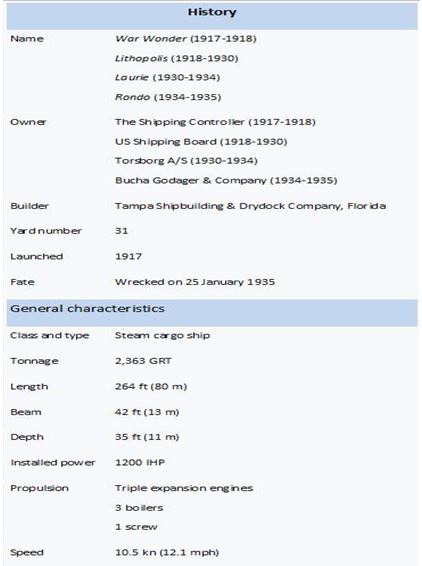
The vessel seen close to completion on the slip alongside the War Wonder at the Tampa Shipbuilding & Dry Dock Company in 1918 above is the SS Everglades, This is what the War Wonder would have ended up like when she was launched had WWI lasted but a few months longer. Dazzle Paint was the brainchild of Norman Wilkinson and likely taken or heavily influenced by the work of Abbot Thayer in his 1909 book “Concealing Coloration in the Animal Kingdom” which described camouflage in the wild as a way to conceal or disrupt
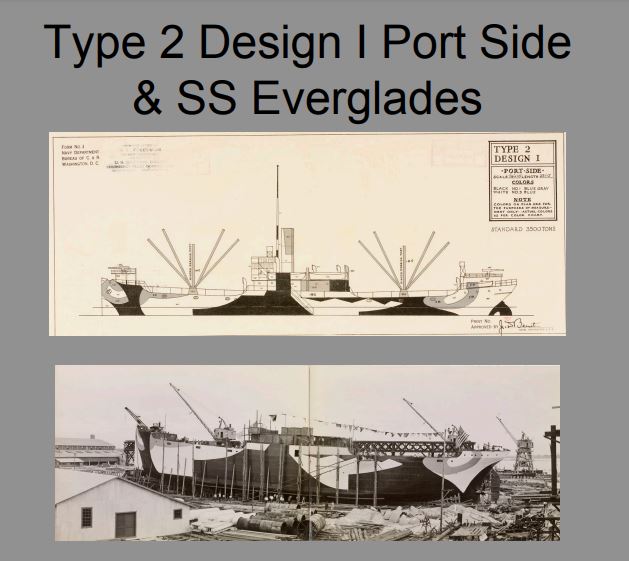
Rhode Island School of Design (RISD) in the USA holds an archive of ship designs and a multitude of the Dazzle Designs, in their slide-set presentation of the collection they note: (Covert. C & Petraits. E: “Dazzle Prints: Digitizing a Large Format Collection” Fleet Library @ RISD. On-line resource: scalabledigital.files.wordpress.com/2008/08/dazzle.pdf Accessed 29/09/21) “Dazzle is disruptive camouflage (think of a zebra). Military camouflage was developed in World War I by French artists. Ships were hard to camouflage against U-boats because the sea and sky were always changing and of the smoke they produced. Norman Wilkinson, a marine painter who was in the Royal Navy is credited with being the first to developed dazzle camouflage for ships. The Royal Navy allowed him to test his idea. When the test went well Wilkinson was told to proceed, however, he was given no office space. So he went to his alma mater the Royal Academy and was given a classroom. Wilkinson hired Vorticist Edward Wadsworth, to be a port officer in Liverpool, England and oversee the painting of dazzle ships. In 1918 Wilkinson came to United States to share his dazzle plans. 1,000 plans were developed through this partnership” The SS Everglades is noted as the first US vessel ever delivered pre-camouflaged, it makes it almost shame the Lithopolis was not in time to have the same livery……..

The Tampa Shipbuilding & Dry Dock Company ownership and function changed to that of a repair yard before U.S. involvement in World War II, 1942 (the shipyard had been mired in a major financial crisis), as one of the merchant shipbuilders selected for the USMC’s pre-war long-range shipbuilding program. It went back to shipbuilding during WWII, employing 16,000 workers, and at its height of operation, was the largest employer in Tampa. Shortly after starting work on its initial USMC contract, however, it again got into financial difficulties and was sold to George B. Howell, who renamed it Tampa Shipbuilding Company, or TASCO the site is now occupied by Gulf Marine Repair

The Rondo had been ordered through the Cunard Steamship Company to avoid contravening America’s “neutral” status in what was to become the last months of World War 1. This ended up an unnecessary artifice as, even before she was complete, America entered the war and such disguise became pointless. As Lithopolis she did not complete fitting out till September 1918, missing any closing actions of the war. It may seem somewhat ridiculous to have employed such subterfuge in order to procure ships from the US, it becomes far less so when “neutrality” can be seen objectively. Germany knew the USA, despite being neutral, had maintained favorable trade links with Great Britain and her allies throughout the War, in fact Germany also traded with the USA right up until her entry into the war on the side of Britain. It was not that either nation could or should challenge the USA’s neutrality as such, it was the diplomatic nature of the trading between each side which could have become an international incident should either of the combatants decided to carry the acts of aggression across the Atlantic to the US coastline

German U Boats had made the crossing several times by 1917, it was a very real possibility that hostilities could have occurred between Great Britain and Germany in sight of the shores of New York. In a paper to the US Congress in December of 1919, just a year after the war ended, Captain C.C. Marsh Officer in Charge of the US Navy Department Historical Section (Marsh. C.C. “German Submarine Activities on the Atlantic Coast of the United States and Canada” Dec 12th 1919) wrote: “It is not believed necessary to go into the discussion based on opinions or surmises during the early years of the war in Europe as to whether or not an attack by the Germans would be made on the American coast. Therefore, the operations herein described are those which actually took place in the year 1918, with a description of the preliminary cruises made by the Deutschland and the U-53 in the year 1916”. The paper goes on to explore the very real journeys of German U Boats to and from US ports and to postulate on the likelihood of incidents between British and German navies accordingly
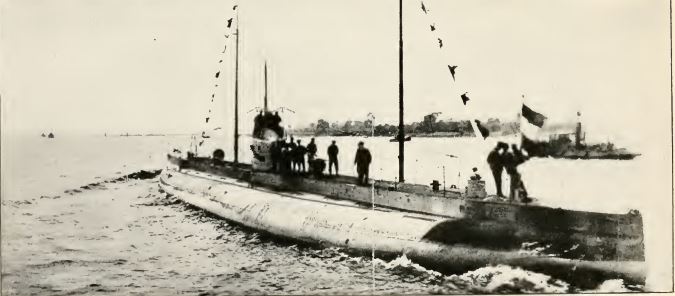
Captain Marsh’s piece occasionally shows a level of expectation arising from the nature of the German U Boat’s various nefarious visits: “…….Of course, it must remain a matter, more or less, of conjecture as to what was actually the object of the cruises made by the Deutschland in 1916. Apparently, they were both purely commercial voyages. The voyage of the U-53 assumes more a character of a path-finding expedition. This vessel was a strictly combative vessel. It is interesting to note that on the arrival of this vessel at Newport, the commanding officer stated to the American submarine that he did not need or want a pilot to enter Newport, and that he wanted no supplies or provisions or materials of any kind….” I think it fair to deduce that Captain Marsh had anticipated, if not expected, incidents of likely breach of the neutrality of US waters….but they never actually occurred
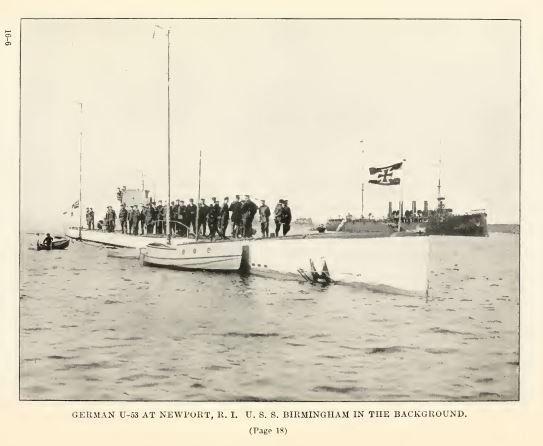
Although it was anticipated War Wonder would be launched into a global conflict the like of which the world had not seen before, she actually took no part in war as the Lithopolis, or later as the Laurie, and she continued to carry out whatever duties her Norwegian owners deemed expedient in the post war years right up until, as the Laurie, in 1934 her name was change to the Rondo. In January 1935 the Rondo, was in Glasgow and left for Dunstan, in ballast, due to pick up a cargo in Northumberland for delivery into Oslo. As she sailed into the Sound of Mull on the 25th of January the weather had gone from bad to appalling, Rondo’s master made the decision to anchor in Aros Bay, near Tobermory, for shelter and to sit out a blinding snowstorm. Believing themselves secured and turning in for the evening, still in the midst of the storm conditions, things took a turn for the worse for Rondo and her crew. Straining against the storm their anchor chain parted and Rondo began drifting down the Sound at the mercy of winds and tide. The Rondo was swept down the sound of Mull and came to rest hard against Dearg Sgeir (Red Skerry, or Red Rocks in Gaelic) near Eileanan Glas, adjacent to the lighthouse placed on the pinnacle to warn of the dangers of the exposed rock outcrop to passing ships
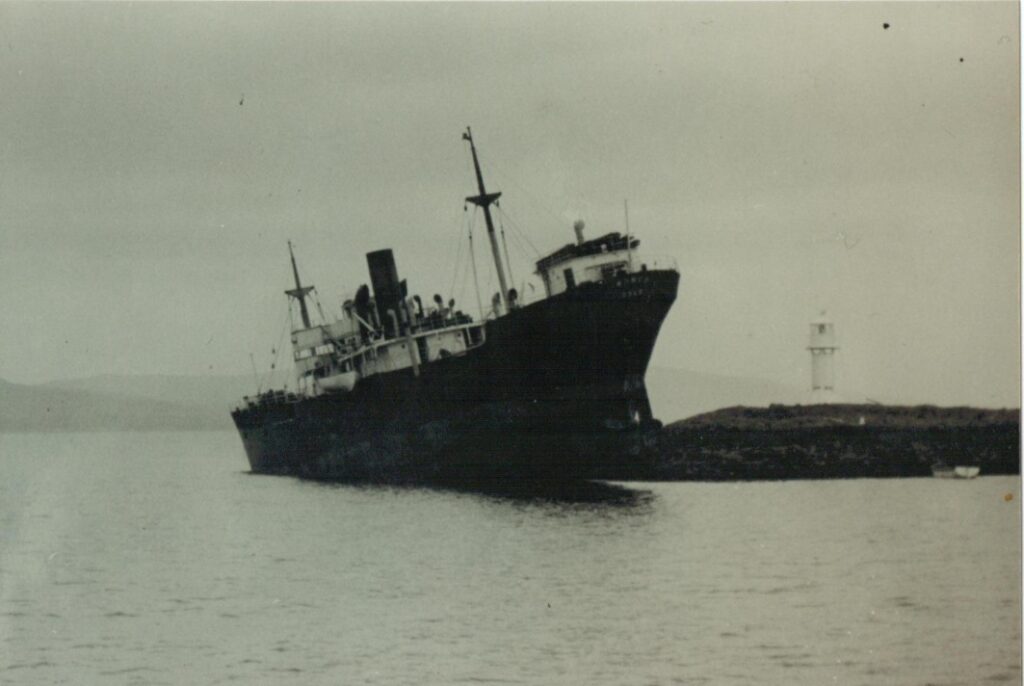
Attempts were made to float Rondo off Dearg Sgeir in the subsequent weeks but whatever was tried was to no avail. It became obvious she would not readily float free and the decision was made to strip out whatever could be readily removed to improve the chances of salvaging her. Whilst the attempt was made Rondo remained controversial, a fire breaking out amongst the wood paneling still aboard having been stripped for removal. It was during this phase of her attempted salvage that things went distinctly sideways. With the lightening of her hull on the rocks, and the movement of the tides against her hull, Rondo finally succumbed to her fate and sank down the submerged rock face of Dear Sgeir until all but her stern post was underwater, eventually she rested, fully submerged, just 10m or so from the surface her bow at 50m and her rudder at around 10 depending on the tide
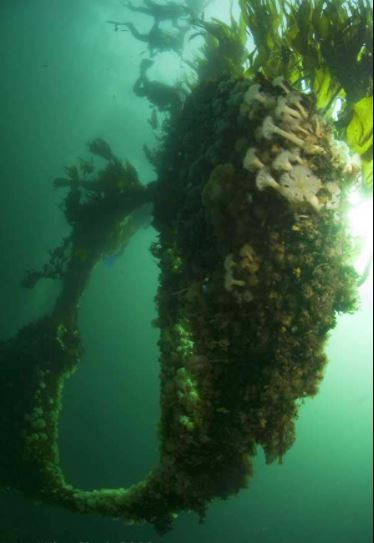
My dive on the Rondo was as part of the first FSAC UK dive Exped, I had been in touch with David Ainsley and booked a party into his accommodation on Seil on the West Coast of Scotland not far from Oban, and places aboard his boat Porpoise, an Atlantic Offshore 105 of which he was rightly very proud, and which was a flawless dive platform during our bank holiday weekend trip to Ardmucknish, Corryveckan and the Sound of Mull. I had Darren & Jason with me as Divemaster’s and a party of recently trained Advanced Open Water Divers who had been co-opted into accompanying Aaron Durber, a local & colourful Stafford Landlord, through Open Water Diver and on into the ocean…….
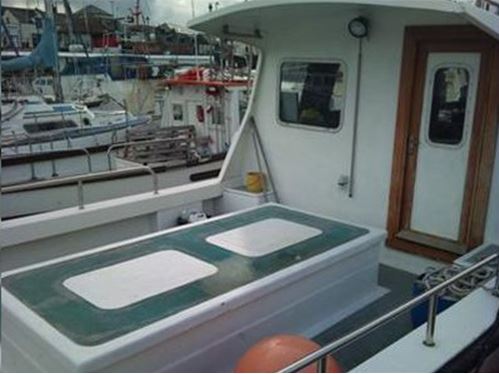
Only Rondo’s shell remains now, you can swim down inside the hull, sheltered from most of a running tide for most of her length, stern to bow, more broken wreckage lies beyond 30 metres and down to the crushed bow at 50 metres. On the return journey there is a choice at various points to swim the outside or stay within the hull. I dived Rondo in 1998 on the first FSAC Scottish dive trip and my little Red Wreck book records: “31/01/98 Sound of Mull, Oban RONDO Rondo holed up in bad weather in Mull and in a real foul patch broke her anchor chain & drifted down the Sound of Mull till hitting rocks and going down. She lies stern up and nearly vertical with the rudder mount @ 6m for ideal deco. There’s not much growth on her (but this was winter) and the hull is bare & easily accessible she was a steam cargo vessel & would bare another dive. Best to go deep then slowly take the rest in Twin 7’s 300 bar independent 2 x Poseidon’s Buddy Colin Woodall”
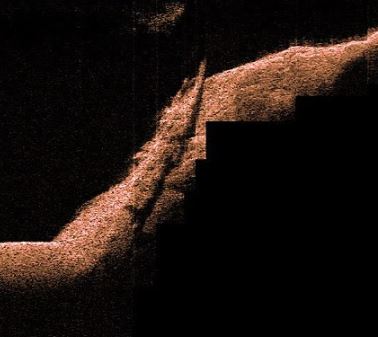
I recall the dive being in good viz throughout and the feeling our descent required more than my normal “dump n drop” technique, a sort of free-fall I’d got used to and enjoyed, this was not the time or place despite the viz and I had Colin with me, we both needed to avoid the exposed pieces of potentially dangerous wreckage, whilst giving each other enough space too. It was an enjoyable dive which we took down to around 25m before turning the dive and slowly ascending back through the sparse wreckage we had dropped past, I don’t recall much in the way of sea life either, there was plenty of kelp and weed, Plumrose Anemones etc, but Rondo was an interesting dive for the way she rested, one of few near vertical wrecks I have dived to this day but I had been warned most of the gear and machinery had been salvaged before she sank and the hull was fairly bare. One of the most interesting wrecks in the sound of Mull though, if only for her aspect and the chance for the adventurous to dive to 50m out of the flow of the sound……
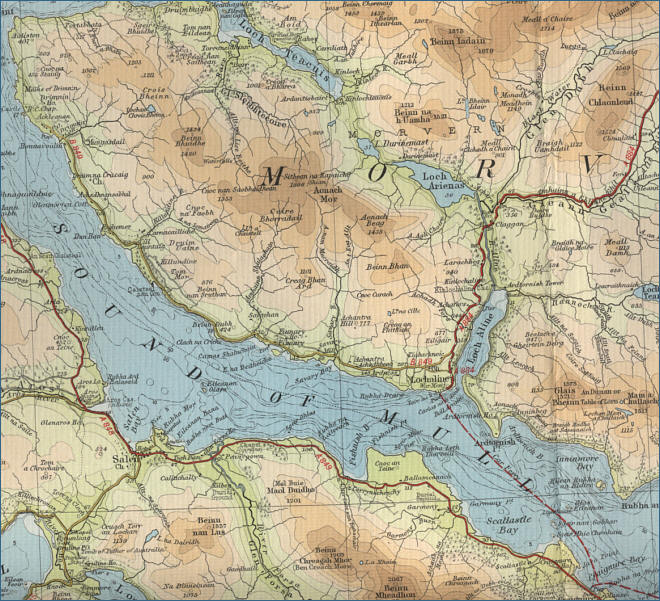
Rondo & The Sound of Mull are another of those locations that I’d love another shot at….perhaps one day!
